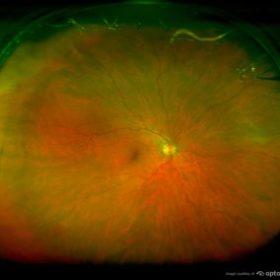Diabetes
Ron Guiley OD, MPH, FAAO Coffman Vision Clinic
Did you know that the retina is often the first place that diabetes is detected? It is also the least invasive. That’s because diabetes is essentially a disease that damages small blood vessels in the eye and throughout the body.
What Causes Diabetes?
It occurs when excessive sugar builds up in the blood.
Who Is Affected?
About 9% (30 million people) of the US population has diabetes, but in the over 65 age group the figure is about 25% (14 million people).
There are two types of diabetes.
1. Type I is caused by an inability of the body to create insulin to break down sugars. This is usually an autoimmune process in which the immune system attacks the cells in the pancreas that produce insulin, and the disease symptoms occur very early in life.
2. The most common form of diabetes is Type II, which is caused by insulin resistance. In this case the body does produce insulin, but it isn’t very effective at controlling blood sugar. This sometimes presents itself initially as metabolic syndrome, where blood sugar is normal but insulin levels are abnormally high due to the body’s extra effort to control blood sugar.
What happens with this radical increase of sugar in the blood?
The structure of blood vessels is damaged, causing them to leak or form clots. The reduced blood flow commonly damages small vessels throughout the body, and especially in the kidneys (nephropathy), the feet (peripheral neuropathy) and the eyes (retinopathy). Diabetes patients are now considered to also have cardiovascular disease.
In the eye, diabetes causes a number of different types of retinal damage. Let’s simplify and choose the most common problems caused in our eyes. They are:
-
- Pre-proliferative retinopathy is usually the first sign of diabetes in the eye. It presents with leaking blood vessels that can produce either small, flame shaped hemorrhages or micro aneurysms, which are small bulges on the sides of blood vessels due to their weakened condition. Damage to these small vessels results in blood or fluid leaking into the surrounding retina, but in early retinopathy no treatment is required.
- Proliferative retinopathy is a severe form of retinal diabetes and results from a lack of oxygen from blocked blood vessels. Starvation of oxygen triggers new blood vessel growth into the retina, but the new vessels are not healthy and leak much more blood and fluid. Scarring results which can detach the retina. Treatment for proliferative retinopathy is required and usually involves either laser and or eye injections.
- Macular edema results when the diabetes causes fluid leaks into the macula, which is the small part of the retina that gives us 20/20 vision. This must be treated with laser or eye injections or vision loss can become permanent.
- Vitreous hemorrhage occurs when blood leaks from the retina into the gel which fills the center of the eye. Vision may be very poor initially, but usually clears up in several weeks to a month, and treatment is not usually necessary.
- Neovascular glaucoma can occur when new blood vessels grow into the canal that drains the fluid out of the eye. Eye pressure can increase dramatically and must be quickly treated with injections into the eye.
About 3% of diabetics go blind from the disease. It is the number one cause of new blindness in ages 24 to 65, and the effects increase with age, duration of the disease and elevated A1C. Many patients do not go blind but have reduced or poor vision from retinal damage. These patients are also frequently dealing with nephropathy and peripheral neuropathy.
Do you feel anything in the eyes when the disease first occurs?
In the initial stages of the disease, patients do not know anything is wrong because there are no symptoms. Early detection is essential. An eye exam with an optometrist is the simplest and easiest way to know if you have diabetic retinopathy.
So how can you reduce your risks?
- Drastically reduce your sugar and carbohydrate intake
- Get two and a half hours of cardiovascular exercise a week.
- Avoid living a sedentary lifestyle. Walk and move.
- Closely watch and control your A1C with your primary care provider.
- Don’t smoke.
- Lose weight. Many diabetic patients are able to get off their medication by losing a substantial amount of weight.
- See your doctor for an annual retinal examination. Most Primary Care Doctors/Providers (PCPs) will ask you if you’ve had an annual eye examination and your eye doctor will send them a report.
The old adage, “Better safe than sorry,” totally applies to stopping diabetes in its tracks.
Come in and see us if you have any questions, or Schedule and Appointment with us if you’d like to have an eye exam.

